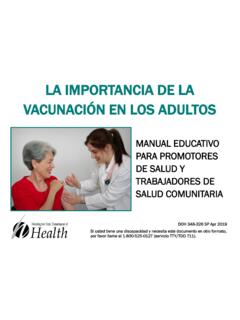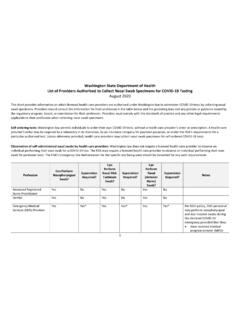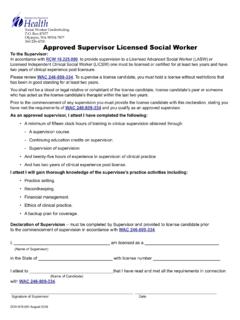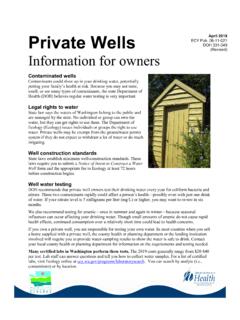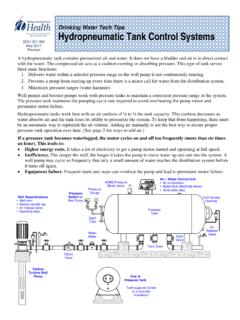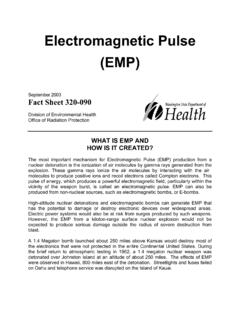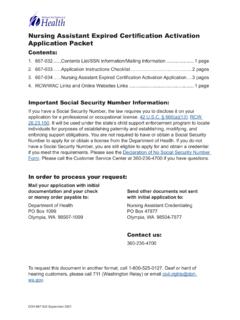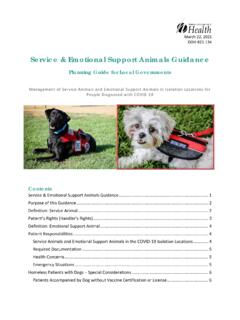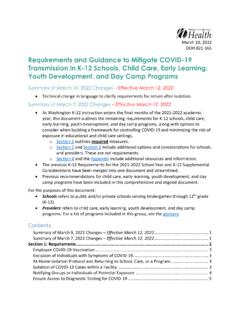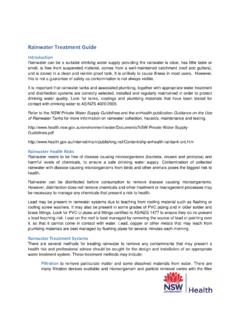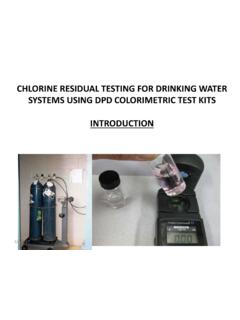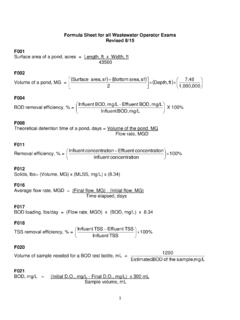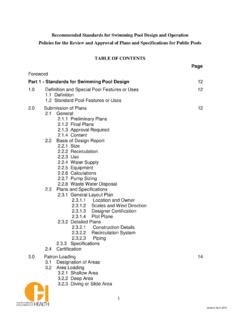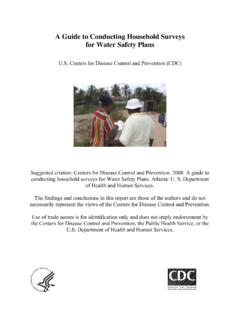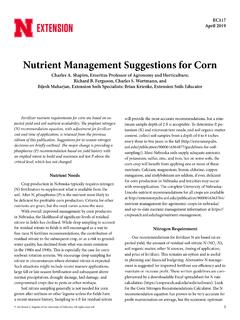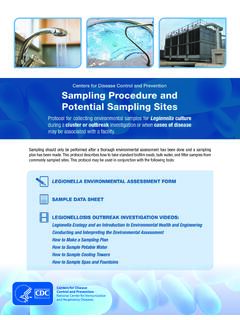Transcription of Drinking Water Tech Tips: Chlorine Contact Time for Small ...
1 Drinking Water Tech Tips: Chlorine Contact Time for Small Water Systems 331-343 Updated July 2016 This Tech Tip is a field guide to help surveyors understand the concept of Chlorine Contact time. You should not use it for design purposes. Washington state Drinking Water rules (WAC 246-290-451) establish minimum Chlorine Contact times for Water sources requiring disinfection. If your Water system is required to disinfect and meet Chlorine Contact time, you must have a professional engineer prepare and submit a project report for our review and approval. To inactivate viruses and bacteria using free Chlorine , the disinfection treatment required before the first customer must be at least 6 milligrams- minutes per liter (6 mg-min/L). This value is commonly referred to as CT.
2 To calculate CT, multiply the free Chlorine residual concentration (C) measured at the end of the Contact time by the time (T) the Water is in Contact with free Chlorine . To get the required CT value of 6, adjust the free Chlorine residual concentration or the Contact time. For example, if Water at the entry point to the distribution system has a free Chlorine residual of mg/L and the Chlorine is in Contact with the Water for 10 minutes between Chlorine injection and entry point to the distribution system, CT is 5 ( mg/L x 10 min = 5 mg-min/L). In this case you could either increase the Chlorine residual to to have a CT of 6 ( mg/L x 10 min = 6 mg-min/L), or increase the Contact time to 12 minutes ( mg/L x 12 min = 6 mg-min/L) to reach the required CT value.
3 The baffling efficiency of a tank is used to determine Chlorine Contact time in the tank. If the Water used to calculate disinfection Contact time moves through a storage tank, pressure tank, or pipes too quickly, the situation is called short-circuiting. Some vessels provide better Contact time than others do. Water systems can modify reservoirs to improve the baffling efficiency. In some cases, such as those outlined below, little or no baffling efficiency can be awarded. The actual baffling efficiency should be determined by using a tracer study or conservatively estimated using current industry guidance from organizations such as the Water Research Foundation. Pipes with a length to width ratio of 150 or more typically have a baffling efficiency of 100 percent.
4 In summary, to calculate CT you must know: 1) The T ( Contact time) for each Water system component between the Chlorine injection point and where free Chlorine is measured before the first customer. 2) The volume and baffling efficiency of each component. 3) The peak flow through each component. 4) The free Chlorine residual measured downstream of all the components and upstream of the first customer. See the example calculation on Page 2. Poor Contact Time Efficiency Baffling Efficiency = 5-10% Poor Contact Time Efficiency Baffling Efficiency = 10% Poor Contact Time Efficiency Baffling Efficiency = 10% No Circulation Baffling Efficiency = 0% Poor Contact Time Efficiency Baffling Efficiency = 5-10% Better Contact Time Efficiency Baffling Efficiency = 10-30% No Circulation Baffling Efficiency = 0% CT measures the effectiveness of a disinfection process.
5 CT = Concentration of free Chlorine (Cmg/L) Contact time (Tminutes) Free Chlorine = Concentration measured in milligrams per liter (mg/L) If you need this publication in an alternative format, call (TDD/TTY call 711). This and other publications are available at For more information Our publications are online at Call our regional office: Eastern Region, Spokane Valley 509-329-2100 Northwest Region, Kent 253-395-6750 Southwest Region, Tumwater 360-236-3030 Diameter Volume of Water per 10 Feet of Pipe 1 inch .042 gallons 1 inch .092 gallons 2 inch gallons 3 inch gallons 4 inch gallons 6 inch gallons 8 inch gallons 12 inch 59 gallons Example CT Calculation Well Pump Capacity = 15 gpm (from source meter) Maximum Design Booster Pumping Rate = 100 gpm (from pump curve) Storage Tank Volume used for Contact Time: Estimated Baffling Efficiency = 10% Total Tank Volume = 20,000 gallons Standby Storage Volume = 5,000 gallons Dead Storage Volume = 1,000 gallons 6,000 Gallons x Baffling Efficiency = 600 gallons Pipe Segment used for Contact Time: Length to width ratio greater than 150 (100% pipe volume available) 4-inch pipe volume = gal per 10 ft x 500 ft = 326 gallons Required Free Chlorine residual based on this example.
6 Time(T) = (600 gals/100 gpm) + (326 gals/100 gpm) = 6 Minutes + Minutes = Minutes CT must be at least 6 mg-min/L during peak flow Required Free Chlorine residual (C) = 6 mg-min/L/ min = mg/L In this example, the free Chlorine residual must be at least mg/L as measured at the entry to the distribution system to adequately inactivate bacteria and viruses. When calculating Contact Time, use the lowest volume of Water in the tank under non-emergency/normal operating conditions.
